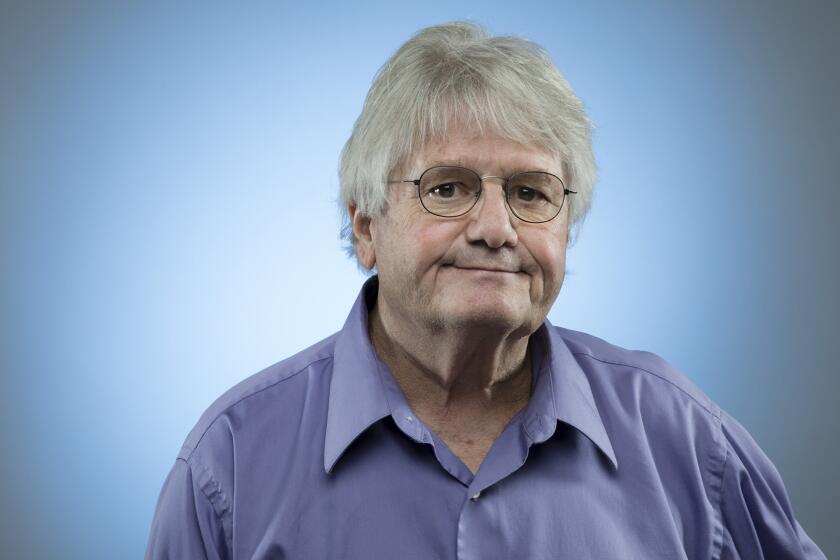Raimund Abraham dies at 76; Austrian-born architect, theorist and teacher

Raimund Abraham, an Austrian-born architect known for his powerfully enigmatic drawings and fierce idealism, and whose narrow, blade-like 2002 Austrian Cultural Forum building in New York is among the most forceful pieces of architecture built in the last decade, was killed early Thursday when the car he was driving collided in downtown Los Angeles with a Metropolitan Transportation Authority bus. He was 76.
The accident, at 5th and Main streets, came just hours after Abraham delivered a lecture Wednesday evening at the Southern California Institute of Architecture, where he had taught periodically since 2003.
With only a handful of completed projects to his credit, Abraham, based for most of his career in New York, was well known in the profession as a theorist and, perhaps most of all, a teacher who struck his students by turns as deeply passionate, gruff and quixotic.
After moving from Austria to the U.S. in 1964, he took a job at the Rhode Island School of Design and, beginning in 1971, taught for more than three decades in New York, primarily at the Cooper Union in Manhattan.
During a Friday afternoon gathering at SCI-Arc’s Arts District campus, Abraham was remembered chiefly for his refusal to bend his designs to meet client demands, architectural fashion or popular taste. “Raimund was pure,” architect and former SCI-Arc Director Michael Rotondi said at the event.
In the last few years, Abraham had been splitting his time among New York, Los Angeles and Mazunte, a small beach town in the Mexican state of Oaxaca where he lived in a house he designed for himself. His other recent projects include the JingYa Ocean Entertainment Center in Beijing and a small, circular concrete music hall in Hombroich, Germany, that is under construction.
Reached by phone Friday in Vienna, Una Abraham, the architect’s daughter and only surviving relative, said work on the music hall would continue. “We’re going to make sure it gets finished,” she said.
Raimund Johann Abraham was born July 23, 1933, in the Austrian mountain town of Lienz, and grew up in a house overlooking the Dolomites.
The experience of living through World War II as a child left an indelible mark on him.
“I had horrifying experiences that shaped my aesthetics,” he once told an interviewer. “I saw buildings disappear that were supposed to be permanent. I saw the entire sky covered with airplanes. But do you have any idea what a beautiful sight that is -- an iron sky? It was magnificent.”
After studying architecture in Graz, Austria, he moved to Vienna, where he worked as an architect and industrial designer from 1959 to 1964, part of a circle of creative talents that included artists, poets and filmmakers.
No project better encapsulated Abraham’s approach than the Austrian Cultural Forum, which squeezes a 280-foot-high tower onto a midtown Manhattan site that is just 25 feet wide. In winning a competition for the building, he beat out 225 other architects, all of them fellow Austrians.
His design called for a tightly compressed set of fire stairs scissoring up the rear of the building -- no other entrant, the competition jurors said, thought to place the stairs there -- and a sharply angled, almost menacing front facade of precisely mitered steel and sheets of glass.
Abraham compared the front of the building to the falling blade of a guillotine, and indeed much of his work was suffused with a sense of foreboding. The building opened just months after the destruction of the World Trade Center towers, and perhaps more than any other piece of architecture of the period it seemed to capture the heavy, fragmented and fragile mood of New York City and fix it permanently in architectural space.
It is also a stunning example of architectural execution, a tough, complex aesthetic vision translated into thrilling form. “Considering that he presents himself as the ultimate bohemian type -- the artist, the provocateur, the poet -- there are two aspects of Raimund that astonish: the impeccable working drawings and his capacity to work out every nut and bolt and carry it to the nth degree,” Kenneth Frampton, an architectural historian who served on the forum jury, told Architectural Record in 2002.
But getting it built to Abraham’s demanding standards was a struggle that consumed a full decade of the architect’s life. Delays and worries about budget overruns plagued the project; in 1996, Abraham was called to defend the building before the Austrian parliament.
“Building is the most difficult form of architecture,” Abraham once said. “It engages you completely. You have to become a street fighter, a lawyer and a detective to succeed.”
Just before the building was completed in early 2002, Abraham, frustrated at the direction of his country’s politics -- in particular the rise of the rightist politician Joerg Haider -- renounced his Austrian citizenship.
Throughout his career, Abraham expressed impatience with the idea that drawing didn’t count as authentic architecture, or that it was simply a preliminary step on the path to construction.
Ultimately, he said, meaningful architecture “is based on an idea. I don’t need a building to verify my idea.”
He returned to that theme in the lecture Wednesday evening at SCI-Arc, arguing that drawing is architecture’s fundamental act.
“You don’t have to become a slave in a corporate office or a groupie of a celebrity architect,” he said. “All you need is a piece of paper, a pencil and the desire to make architecture.”
Hawthorne is the Times’ architecture critic.
christopher.hawthorne
@latimes.com
More to Read
Start your day right
Sign up for Essential California for the L.A. Times biggest news, features and recommendations in your inbox six days a week.
You may occasionally receive promotional content from the Los Angeles Times.







